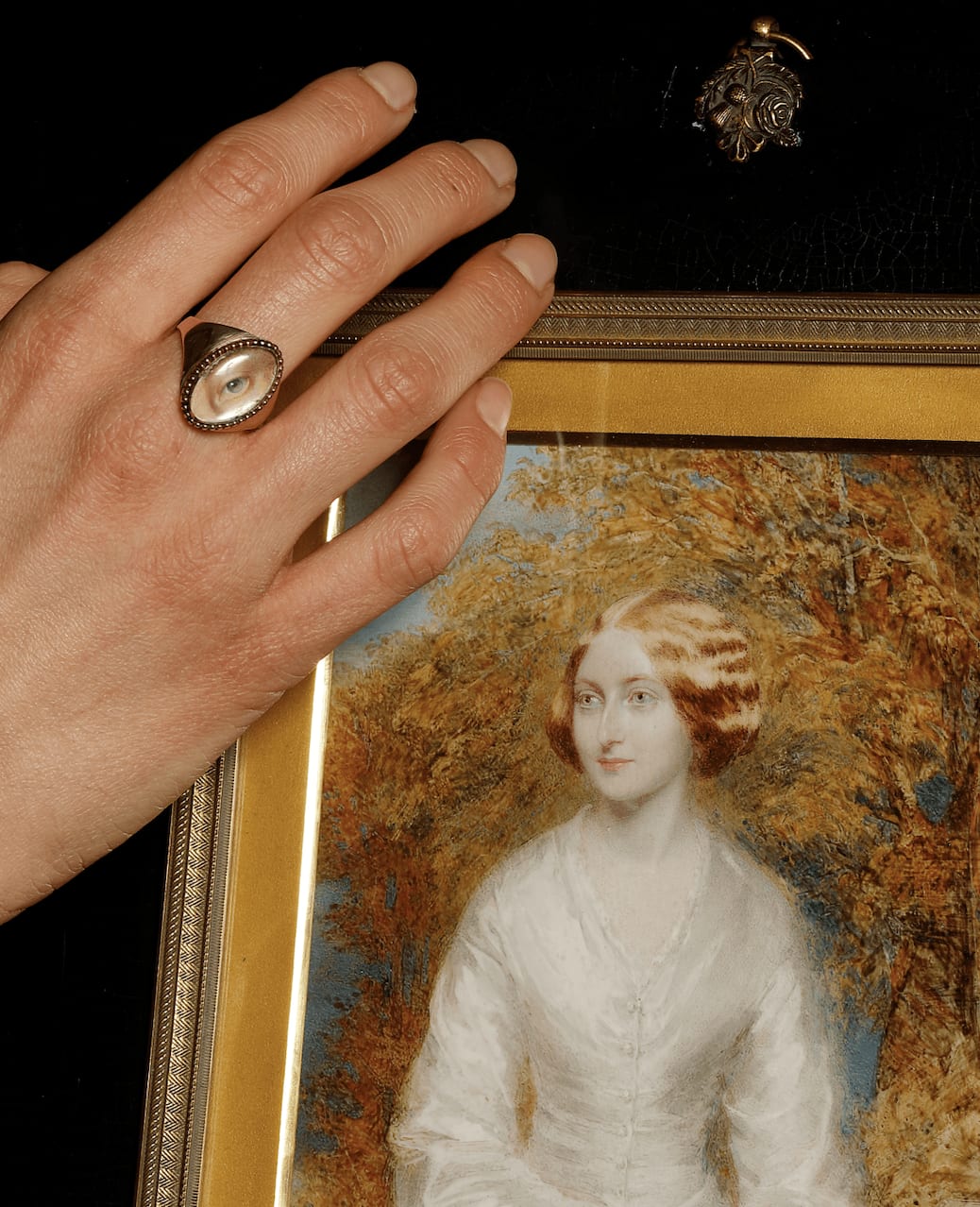Defying neat categorisation, eye miniatures rest somewhere between jewellery and art.
They were popular for a short period in the late eighteenth and early nineteenth centuries and were typically exchanged between lovers as a secretive, romantic token. These tiny miniature portraits were usually secured within items of jewellery – brooches, lockets, rings – in the hope that the recipient would keep or wear them on their person.
The miniature I am writing about today is no exception. Mounted on a ring, the present eye miniature gazes directly out to its viewer. Due to their minute scale, most eye miniatures are unsigned, which can often sadly lead to the loss of the identity of both artist and sitter. However, in this incredibly rare instance, we can identify the sitter with the help of a corresponding portrait commissioned at the same date.
The present miniature depicts Miss Louisa Cooke (later Mrs. Day of Amesbury), as stated on the reverse. Since their creation, this miniature and the corresponding eye miniature have remained united. That this ring has remained in the same collection as its corresponding portrait enables an accurate identification of the original sitter as Cooke’s husband – who likely commissioned both portraits. This paring optimises the romantic nuances which have governed the production of portrait miniatures throughout history.
The rarity of this intact union between portrait miniature and 'eye' miniature cannot be overstated.
Both works were painted by artist Augusta Elizabeth Cole (later Samwell). Working predominantly in oils and watercolours, Cole built a career as a professional miniaturist during the mid-nineteenth century.
Born in Stoke Damerel, Plymouth, Cole was the eldest of nine children born to Robert Cole (1790-1867) and Mary Cole (née Maye), three of which died in infancy. Creativity and ingenuity evidently suffused family life in the Cole household; her brother, John Jenkins Cole, became an architect and two of her younger sisters, Anna Maria and Mary Anne, also became artists. At 14, Mary Cole died ad the family soon moved to London, where they occupied a house in Red Lion Square.
In 1834, Cole's artistic talents were recognised by 'The Society of Arts, Manufacturers and Commerce' - later abbreviated to 'The Society of Arts' - and she was bestowed 'the large silver medal' in the professional artists category for original works.[1] The prize was awarded to Cole whilst she was living at 12 Taunton place, London. Less than a year later, in 1835, Cole exhibited for the first time at The Royal Academy with a miniature simply entitled Portrait of a Lady. Cole exhibited extensively at the Royal Academy throughout her career from 1835 to 1869, exhibiting 75 works to their annual shows in total. She also exhibited regularly at the annual exhibitions of the Royal Society of British Artists between 1932 and 1957.
The portrait of Cooke was exhibited in the 1852 Royal Academy’s Eighty-Fourth Exhibition, in the South Room within the Drawings and Miniatures section. Cole’s reputation as a skilled miniaturist was recognised among her contemporaries. Two years earlier, her portrait of Mrs Charles Salaman had been praised in The Art Journal’s review of the Royal Academy’s Eighty-Second Exhibition; ‘A miniature, distinguished by much good taste in the simplicity of its treatment.’ [2]
Augusta Cole ceased exhibiting under her maiden name when she married Peter Francis Billard Samwell in 1861, after which she exhibited under the name Mrs. Samwell. The wide range of sitters who sat for Cole, such as Lord William Fitzroy, Princess Mary and Madame Valerie of Rome, is a testament to her industrious practise.
The historical phenomenon of eye miniatures slowly grew out of fashion throughout Cole’s career. In fact, this form of highly personal, erotically charged painting would have arguably been considered anachronistic by the time this miniature was commissioned. This secretive paring – romantic and mysterious - offers a glimpse into an alternative psyche presented by the buttoned-up, sexually repressed, early Victorian era.
[1] (1838) ‘Rewards Bestowed by the Society During the Session 1834-5’, Transactions of the Society of Arts, Manufacturers, and Commerce. Vol. II, London: Dodsley, Lockyer, p. xiv, (accessed on 24.11.21) [available at: google books ]
2. (1850), ‘The Royal Academy. The Eighty-Second Exhibition – 1850’. The Art-Journal. 1 June 1850, London: Virtue and Co., p. 177.









